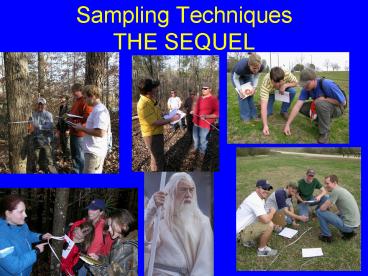Sampling Techniques THE SEQUEL - PowerPoint PPT Presentation
1 / 24
Title:
Sampling Techniques THE SEQUEL
Description:
Often we want to know how 'important' plant species are in a sampled area ... 1) Quadrat. 2) Belt transect. 3) Line intercept. 4) Plotless (distance) methods ... – PowerPoint PPT presentation
Number of Views:463
Avg rating:3.0/5.0
Title: Sampling Techniques THE SEQUEL
1
Sampling TechniquesTHE SEQUEL
2
Warning!
- This material (and last weeks lab lecture on
sampling) will be included on Lecture Exam 1!
3
Importance
- Often we want to know how important plant
species are in a sampled area - Measures of importance of a species (sp. A)
- Density of A No. inds. per unit area (reflects
abundance of A) - Frequency of A No. of times sp. A found in
samples divided by total number of samples taken
(reflects pattern of A) - Cover of A Percent of area occupied by A in
sampled area (reflects biomass of A)
4
Methods
- 1) Quadrat
- 2) Belt transect
- 3) Line intercept
- 4) Plotless (distance) methods
5
Plotless (distance) methods
- Based on points
- Points have no dimensions, so this 0 dimensional
method - Often used with trees, as one samples along a
transect through the forest
6
Plotless (distance) methods
- Information Collected
- 1) tree identity
- 2) tree size (reflects biomass or cover)
- 3) distance measurement (from something to
something)
7
Plotless (distance) methods
- Method 1 Nearest individual method
8
Plotless (distance) methods
- Method 2 Nearest neighbor method
9
Plotless (distance) methods
- Method 3 Random pairs method
- A) find nearest plant
- B) draw line from pt to plant
- C) make exclusion zone
- D) measure distance to nearest plant outside zone
10
Plotless (distance) methods
- Method 4 Point centered quarter method
11
Plotless (distance) methods
- Information Collected
- 1) tree identity
- 2) tree size (reflects biomass or cover)
- 3) distance measurement (from something to
something) - IV Rel. density Rel. frequency Rel. cover
- lt300 lt100 lt 100 lt 100
- How get rel. density, rel. frequency, rel. cover
values from this information?
12
Plotless (distance) methods
- Cover have DBH values for each tree
- Convert DBH to area of trunk for each species
- relative cover of species Y
- Cover of Y/Cover of all species X 100
13
Plotless (distance) methods
- Frequency Have tree identities for each point
- frequency of species Y
- No. pts. with species Y/Total number pts. X 100
- rel. freq. of sp. Y
- Freq. of Y/freq. all species X 100
- IV Rel. density Rel. frequency Rel. cover
14
Plotless (distance) methods
- Density ?? No areas were measured??
- Relies on geometric principle as density
increases distances measured should decrease - Note importance of random placement of points to
this relationship!
15
Plotless (distance) methods
- Steps
- 1) Calculate mean distance (D) for all trees
sampled - 2) Use magic formula
- Density (all species) A/(correction factor)(D)2
- To express results in metric units
- A10,000 m2/hectare (ha)
- D should be in meters (m)
- Correction factor?
16
Plotless (distance) methods
- Steps
- Correction factor?
- 2 for nearest individual method
- 1.67 for nearest neighbor method
- 0.8 for random pairs method
- 1 for point centered quarter method
- 3) Calculate density of species Y
- No. Y/No. all species X Density all species
- 4) rel. density of Y
- Density of Y/Density all species X 100
17
Plotless (distance) methods
- Can now calculate IV of species Y
- IV Rel. density Rel. frequency Rel. cover
- lt300 lt100 lt 100 lt 100
- Repeat calculations for all other species
18
Plotless (distance) methods
- Note on Point Centered Quarter method
- 1) Get more data per point
- 2) Relatively simple method
- 3) No correction factor needed in density formula
(correction factor 1)
19
How place sample units?
- Generally, random is best
- How define?
- All potential sample units have equal chance of
inclusion in sample - Why best?
- Eliminates bias on part of sampler
- May be required to use statistics or other
equations (e.g., density formula for plotless
methods) on the data
20
How place sample units?
- Note random not same as
- Arbitrary Choosing while attempting to eliminate
conscious bias - Systematic Choosing using numeric pattern (ex,
every 5th tree along transect) - Deliberate Choosing with list of criteria (ex,
all trees gt 30 cm dbh)
21
How place sample units?
- But, random may not always give representative
sample - Example
X
X
X
X
X
X
X
X
X
X
X
22
How place sample units?
- Techniques
- Random
- vs.
- Stratified random (subdivide area and sample
randomly in each division)
23
How place sample units?
- Techniques
- Systematic
24
How place sample units?
- Techniques
- Random-Systematic (select starting place
randomly, place points on transect systematically
or vice versa)
systematic
random
systematic
random
OR































